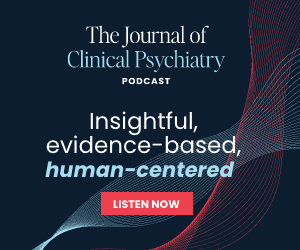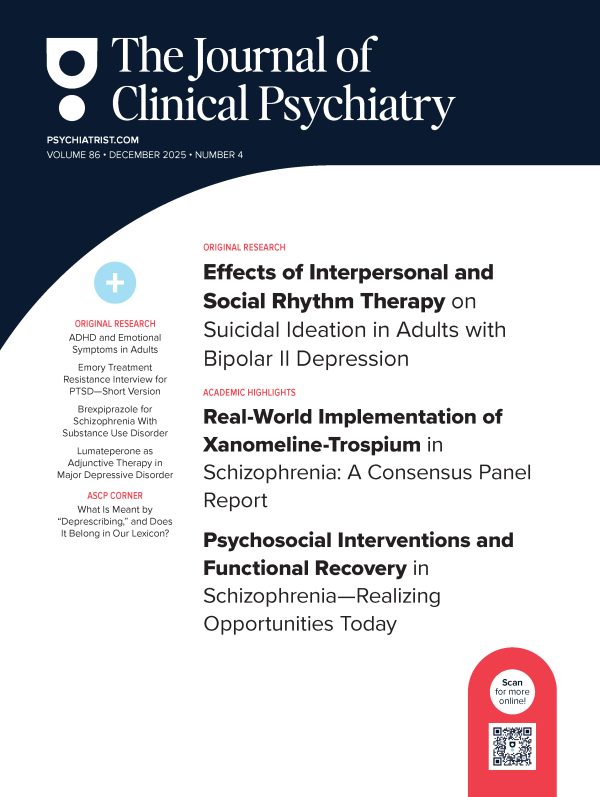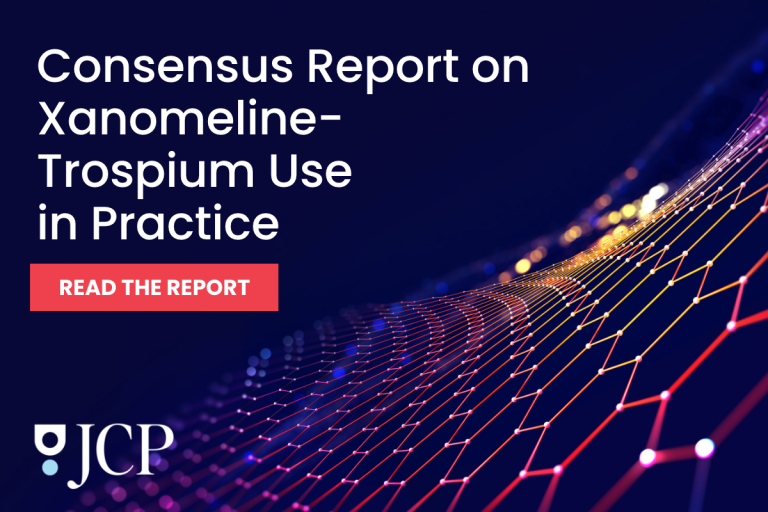Abstract
Objective: Individuals with bipolar II disorder (BD II) have among the highest rates of suicide ideation (SI), attempts, and deaths. No studies to date have examined psychosocial treatment of SI in adults with BD II. The purpose of this study was to investigate whether patients with BD II depression receiving interpersonal and social rhythm therapy (IPSRT), an evidence-based psychotherapy for BD, experienced a decrease in SI, and whether this varied by use of adjunctive medication compared to IPSRT monotherapy.
Methods: In a post hoc analysis of Swartz et al (2018), adults meeting DSM-IV criteria for BD II, currently depressed (n=92), were randomly assigned to receive IPSRT+placebo (IPSRT+P) or IPSRT+quetiapine (IPSRT+Q) and treated for 20 weeks. SI was assessed at baseline and weekly using the 17-item Hamilton Depression Rating Scale item 3. Multilevel logistic regression was used to model SI categorically.
Results: The results demonstrate a decrease in odds of SI over time (OR=0.8719, 95% CI, 0.8166–0.9309, P≤.001), with a 13% decrease in the odds of having SI for each additional week of treatment. There was no significant difference between those receiving IPSRT+P vs IPSRT+Q.
Conclusions: IPSRT has the potential to mitigate suicidal ideation in patients with BD II depression, regardless of whether they receive medication in addition to IPSRT. IPSRT alone may be a reasonable option to treat SI in an outpatient setting for some patients with BD II, especially those for whom medication is contraindicated or who prefer avoiding medication.
Trial Registration: ClinicalTrials.gov identifier: NCT01133821.
J Clin Psychiatry 2025;86(4):24m15768
Author affiliations are listed at the end of this article.
Members Only Content
This full article is available exclusively to Professional tier members. Subscribe now to unlock the HTML version and gain unlimited access to our entire library plus all PDFs. If you’re already a subscriber, please log in below to continue reading.
References (62)

- Centers for Disease Control and Prevention (CDC). Life expectancy increases, however suicides up in 2022. CDC; 2023. Accessed September 17,2025.https://www.cdc.gov/nchs/pressroom/nchs_press_releases/2023/20231129.htm
- Schaffer A, Isometsä ET, Tondo L, et al. International Society for Bipolar Disorders Task Force on Suicide: meta-analyses and meta-regression of correlates of suicide attempts and suicide deaths in bipolar disorder. Bipolar Disord. 2015;17(1):1–16. PubMed CrossRef
- Plans L, Barrot C, Nieto E, et al. Association between completed suicide and bipolar disorder: a systematic review of the literature. J Affect Disord. 2019;242:111–122. PubMed CrossRef
- Valtonen H, Suominen K, Mantere O, et al. Suicidal ideation and attempts in bipolar I and II disorders. J Clin Psychiatry. 2005;66(11):1456–1462. PubMed CrossRef
- Pompili M, Gonda X, Serafini G, et al. Epidemiology of suicide in bipolar disorders: a systematic review of the literature. Bipolar Disord. 2013;15(5):457–490. PubMed CrossRef
- Merikangas KR, Lamers F. The “true” prevalence of bipolar II disorder. Curr Opin Psychiatry. 2012;25(1):19–23. PubMed CrossRef
- Rosa AR, Bonnín CM, Vázquez GH, et al. Functional impairment in bipolar II disorder: is it as disabling as bipolar I? J Affect Disord. 2010;127(1–3):71–76. PubMed CrossRef
- Benazzi F. Suicidal ideation and bipolar-II depression symptoms. Hum Psychopharmacol. 2005;20(1):27–32. PubMed CrossRef
- Dell’Osso B, Holtzman JN, Goffin KC, et al. American tertiary clinic-referred bipolar II disorder compared to bipolar I disorder: more severe in multiple ways, but less severe in a few other ways. J Affect Disord. 2015;188:257–262. PubMed CrossRef
- Janiri D, Sani G, Danese E, et al. Childhood traumatic experiences of patients with bipolar disorder type I and type II. J Affect Disord. 2015;175:92–97. PubMed CrossRef
- Judd LL, Akiskal HS, Schettler PJ, et al. The comparative clinical phenotype and long term longitudinal episode course of bipolar I and II: a clinical spectrum or distinct disorders? J Affect Disord. 2003;73(1–2):19–32. PubMed CrossRef
- Oquendo MA, Mann JJ. Identifying and managing suicide risk in bipolar patients. J Clin Psychiatry. 2001;62(suppl 25):31–34. PubMed
- Marangell LB, Bauer MS, Dennehy EB, et al. Prospective predictors of suicide and suicide attempts in 1,556 patients with bipolar disorders followed for up to 2 years. Bipolar Disord. 2006;8(5 Pt 2):566–575. PubMed CrossRef
- Undurraga J, Baldessarini RJ, Valenti M, et al. Suicidal risk factors in bipolar I and II disorder patients. J Clin Psychiatry. 2012;73(6):778–782. PubMed CrossRef
- DeCou CR, Comtois KA, Landes SJ. Dialectical behavior therapy is effective for the treatment of suicidal behavior: a meta-analysis. Behav Ther. 2019;50(1):60–72. PubMed CrossRef
- Wasserman D, Rihmer Z, Rujescu D, et al. The European Psychiatric Association (EPA) guidance on suicide treatment and prevention. Eur Psychiatry. 2012;27(2):129–141. PubMed CrossRef
- Hepp U, Wittmann L, Schnyder U, et al. Psychological and psychosocial interventions after attempted suicide: an overview of treatment studies. Crisis. 2004;25(3):108–117. PubMed CrossRef
- Stanley B, Brodsky BS, Nelson JD, et al. Brief dialectical behavior therapy (DBT-B) for suicidal behavior and non-suicidal self-injury. Arch Suicide Res. 2007;11(4):337–341. PubMed CrossRef
- Stanley B, Brown G, Brent DA, et al. Cognitive-behavioral therapy for suicide prevention (CBT-SP): treatment model, feasibility, and acceptability. J Am Acad Child Adolesc Psychiatry. 2009;48(10):1005–1013. PubMed CrossRef
- Brown GK, Jager-Hyman S. Evidence-based psychotherapies for suicide prevention: future directions. Am J Prev Med. 2014;47(3 suppl 2):S186–S194. PubMed CrossRef
- Tarrier N, Taylor K, Gooding P. Cognitive-behavioral interventions to reduce suicide behavior: a systematic review and meta-analysis. Behav Modif. 2008;32(1):77–108. PubMed CrossRef
- Franklin JC, Ribeiro JD, Fox KR, et al. Risk factors for suicidal thoughts and behaviors: a meta-analysis of 50 years of research. Psychol Bull. 2017;143(2):187–232. PubMed CrossRef
- Yatham LN, Kennedy SH, Parikh SV, et al. Canadian Network for Mood and Anxiety Treatments (CANMAT) and International Society for Bipolar Disorders (ISBD) 2018 guidelines for the management of patients with bipolar disorder. Bipolar Disord. 2018;20(2):97–170. PubMed CrossRef
- O’Carroll PW, Berman AL, Maris R, et al. Beyond the Tower of Babel: a nomenclature for suicidology. In: Maris RW, Silverman MM, Neimeyer MP, eds. Suicide Prevention: The Global Context. Plenum Press; 1998:23–39.
- Silverman MM, Berman AL, Sanddal ND, et al. Rebuilding the Tower of Babel: a revised nomenclature for the study of suicide and suicidal behaviors. Part 1: background, rationale, and methodology. Suicide Life Threat Behav. 2007;37(3):248–263. PubMed CrossRef
- Malhi GS, Bargh DM, Kuiper S, et al. Modeling bipolar disorder suicidality. Bipolar Disord. 2013;15(5):559–574. PubMed CrossRef
- Novick DM, Swartz HA, Frank E. Suicide attempts in bipolar I and bipolar II disorder: a review and meta-analysis of the evidence. Bipolar Disord. 2010;12(1):1–9. PubMed CrossRef
- Rucci P, Frank E, Kostelnik B, et al. Suicide attempts in patients with bipolar I disorder during acute and maintenance phases of intensive treatment with pharmacotherapy and adjunctive psychotherapy. Am J Psychiatry. 2002;159(7):1160–1164. PubMed CrossRef
- Jobes DA, Joiner TE. Reflections on suicidal ideation. Crisis. 2019;40(4):227–230. PubMed CrossRef
- Craighead WE, Dunlop BW. Combination psychotherapy and antidepressant medication treatment for depression: for whom, when, and how. Annu Rev Psychol. 2014;65:267–300. PubMed CrossRef
- Kappelmann N, Rein M, Fietz J, et al. Psychotherapy or medication for depression? Using individual symptom meta-analyses to derive a Symptom-Oriented Therapy (SOrT) metric for a personalised psychiatry. BMC Med. 2020;18(1):170. PubMed CrossRef
- Sankar A, Panchal P, Goldman D, et al. Telehealth social rhythm therapy to reduce mood symptoms and suicide risk among adolescents and young adults with bipolar disorder. Am J Psychother. 2021;74(4):172–177. PubMed CrossRef
- Swartz HA, Rucci P, Thase ME, et al. Psychotherapy alone and combined with medication as treatments for bipolar II depression: a randomized controlled trial. J Clin Psychiatry. 2018;79(2):16m11027. PubMed CrossRef
- Miklowitz DJ, Otto MW, Frank E, et al. Psychosocial treatments for bipolar depression: a 1-year randomized trial from the Systematic Treatment Enhancement Program. Arch Gen Psychiatry. 2007;64(4):419–426. PubMed CrossRef
- Correll CU, Detraux J, De Lepeleire J, et al. Effects of antipsychotics, antidepressants and mood stabilizers on risk for physical diseases in people with schizophrenia, depression, and bipolar disorder. World Psychiatry. 2015;14(2):119–136. PubMed CrossRef
- Newcomer JW. Second-generation (atypical) antipsychotics and metabolic effects: a comprehensive literature review. CNS Drugs. 2005;19(suppl 1):1–93. PubMed CrossRef
- Serretti A, Chiesa A, Calati R, et al. Side effects associated with psychotropic medications in patients with bipolar disorder: evidence from two independent samples. J Psychopharmacol. 2013;27(7):616–628. PubMed CrossRef
- First MB, Spitzer RL, Gibbon M, et al. Structured Clinical Interview for DSM-IV Axis I Disorders (SCID). New York State Psychiatric Institute, Biometrics Research; 1995.
- Hamilton M. A rating scale for depression. J Neurol Neurosurg Psychiatry. 1960;23(1):56–62. PubMed CrossRef
- Thase ME, Carpenter L, Kupfer DJ, et al. Clinical significance of reversed vegetative subtypes of recurrent major depression. Psychopharmacol Bull. 1991;27(1):17–22. PubMed
- Young RC, Biggs JT, Ziegler VE, et al. A rating scale for mania: reliability, validity, and sensitivity. Br J Psychiatry. 1978;133:429–435. PubMed CrossRef
- Wagner EF, Frank E, Steiner SC. Discriminating maintenance treatments for recurrent depression: development and implementation of a rating scale. J Psychother Pract Res. 1992;1(3):280–290. PubMed
- Ehlers CL, Frank E, Kupfer DJ. Social zeitgebers and biological rhythms: a unified approach to understanding the etiology of depression. Arch Gen Psychiatry. 1988;45(10):948–952. PubMed CrossRef
- Frank E, Kupfer DJ, Thase ME, et al. Two-year outcomes for interpersonal and social rhythm therapy in individuals with bipolar I disorder. Arch Gen Psychiatry. 2005;62(9):996–1004. PubMed CrossRef
- Miklowitz DJ, Otto MW, Frank E, et al. Intensive psychosocial intervention enhances functioning in patients with bipolar depression: results from a 9-month randomized controlled trial. Am J Psychiatry. 2007;164(9):1340–1347. PubMed CrossRef
- Frank E. Treating Bipolar Disorder: A Clinician’s Guide to Interpersonal and Social Rhythm Therapy. Guilford Press; 2007. Accessed September 17, 2025. https://playgoogle.com/store/books/details?id=cRMzWcXgFeAC
- Levenson JC, Wallace ML, Anderson BP, et al. Social rhythm disrupting events increase the risk of recurrence among individuals with bipolar disorder. Bipolar Disord. 2015;17(8):869–879. PubMed CrossRef
- Malkoff-Schwartz S, Frank E, Anderson BP, et al. Social rhythm disruption and stressful life events in the onset of bipolar and unipolar episodes. Psychol Med. 2000;30(5):1005–1016. PubMed CrossRef
- Shen GHC, Alloy LB, Abramson LY, et al. Social rhythm regularity and the onset of affective episodes in bipolar spectrum individuals. Bipolar Disord. 2008;10(4):520–529. PubMed CrossRef
- Sylvia LG, Alloy LB, Hafner JA, et al. Life events and social rhythms in bipolar spectrum disorders: a prospective study. Behav Ther. 2009;40(2):131–141. PubMed CrossRef
- Desseilles M, Perroud N, Guillaume S, et al. Is it valid to measure suicidal ideation by depression rating scales? J Affect Disord. 2012;136(3):398–404. PubMed CrossRef
- Enders CK, Du H, Keller BT. A model-based imputation procedure for multilevel regression models with random coefficients, interaction effects, and nonlinear terms. Psychol Methods. 2020;25(1):88–112. PubMed CrossRef
- Keller BT, Enders CK. Blimp User’s Manual (Version 2.0). 2019.
- Young R, Johnson DR. Handling missing values in longitudinal panel data with multiple imputation. J Marriage Fam. 2015;77(1):277–294. PubMed CrossRef
- Enders CK. Multiple imputation as a flexible tool for missing data handling in clinical research. Behav Res Ther. 2017;98:4–18. PubMed CrossRef
- Pancheri P, Picardi A, Pasquini M, et al. Psychopathological dimensions of depression: a factor study of the 17-item Hamilton Depression Rating Scale in unipolar depressed outpatients. J Affect Disord. 2002;68(1):41–47. PubMed CrossRef
- Sharp R. The Hamilton Rating Scale for Depression. Occup Med (Lond). 2015;65(4):340. PubMed CrossRef
- McMain SF, Links PS, Gnam WH, et al. A randomized trial of dialectical behavior therapy versus general psychiatric management for borderline personality disorder. Am J Psychiatry. 2009;166(12):1365–1374. PubMed CrossRef
- Deckersbach T, Peters AT, Sylvia LG, et al. A cluster analytic approach to identifying predictors and moderators of psychosocial treatment for bipolar depression: results from STEP-BD. J Affect Disord. 2016;203:152–157. PubMed CrossRef
- Magalhães PV, Dodd S, Nierenberg AA, et al. Cumulative morbidity and prognostic staging of illness in the Systematic Treatment Enhancement Program for Bipolar Disorder (STEP-BD). Aust N Z J Psychiatry. 2012;46(11):1058–1067. PubMed CrossRef
- Benard V, Etain B, Vaiva G, et al. Sleep and circadian rhythms as possible trait markers of suicide attempt in bipolar disorders: an actigraphy study. J Affect Disord. 2019;244:1–8. PubMed CrossRef
- Barrett MS, Chua WJ, Crits-Christoph P, et al. Early withdrawal from mental health treatment: implications for psychotherapy practice. Psychotherapy. 2008;45(2):247–267. PubMed CrossRef






